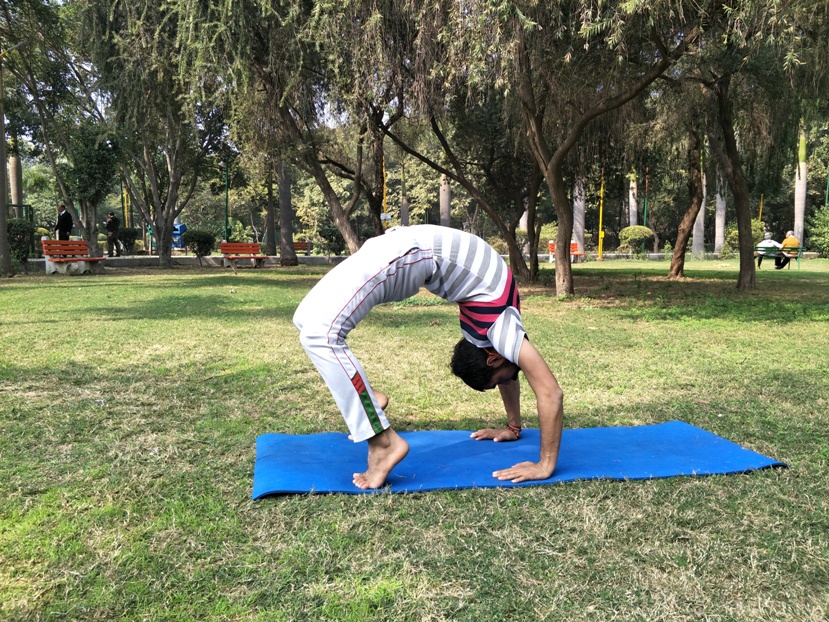
Haṭh Yoga
Haṭh yoga is a branch of yoga. The Sanskrit word हठ Haṭh literally means "force" and thus alludes to a system of physical techniques. In India, Haṭh yoga is associated in popular tradition with the 'Yogis' of the Natha Sampradaya through its traditional founder Matsyendranath. Almost all hathayogic texts belong to the Nath siddhas, and the important ones are credited to Matsyendranath's disciple, Gorakhnath or Gorakshanath. Matsyendranath, also known as Minanath or Minapa in Tibet, is celebrated as a saint in both Hindu and Buddhist tantric and Haṭh yoga schools. However, James Mallinson associates Haṭh yoga with the Dashanami Sampradaya and the mystical figure of Dattatreya.According to the Dattatreya Yoga Sastra, there are two forms of Haṭh yoga: one practiced by Yajnavalkya consisting of the eight limbs of ashtanga yoga and another practiced by Kapila consisting of eight mudras. Currently, the oldest dated text to describe Haṭh yoga, the 11th-century CE Amṛtasiddhi, comes from a tantric Buddhist milieu.The oldest texts to use the terminology of hatha are also Vajrayana Buddhist. Later Haṭh yoga texts adopt the practices of Haṭh yoga mudras into a Saiva system, melding it with Layayoga methods which focus on the raising of kuṇḍalini through energy channels and chakras. In the 20th century, a development of Haṭh yoga, focusing particularly on asanas (the physical postures), became popular throughout the world as a form of physical exercise. This modern form of yoga is now widely known simply as "yoga".
Hatha yoga for beginner
Opening Om chanting one time
गायत्री मंत्र 'ऊं भूर्भुव: स्व: तत्सवितुर्वरेण्यं भर्गो देवस्य धीमहि। धियो यो न: प्रचोदयात्।।

{'सृष्टिकर्ता प्रकाशमान परामात्मा के तेज का हम ध्यान करते हैं, परमात्मा का वह तेज हमारी बुद्धि को सद्मार्ग की ओर चलने के लिए प्रेरित करें}
Kundalini asthi Granthi Kriya (Joints movements) Feet and ankle exercises
- Knee movement
- Leg cradle
- Side being
- Arm swing
- Elbow movement
- Wrist and hand movement
- Neck exercises
- Chin, jaw, mouth, tongue, eye and head exercises
Kundalini Yoga Asana:
Standing Asana
- Prarthanasana (The prayer pose -to have reverence)
- Padahastasana (The standing forward bend – to awake Muladhar Chakra)
- Tadasana (The Tree Pose – for nourishing our spiritual aspiration)
- Hip movement and rotation
- Garudasana (The Eagle pose – improve balance and co-ordination
- Trikonasana (The Triangle pose)
- Virabhadrasana (The Warrior Pose)
Standing Poses
- Ardha Matsyendrasana (The Lord of the Fishes pose)
- Paschimottanasana (The back stretching pose)
- Purvottanasana (Upward Plank Pose)
- Janushirshasana A (The head to knee pose- eliminate laziness and weakness
- Vajrasana (Thunderbolt pose -to cleanse Vajra nadi to promote ascendance of the sexual energy towards upper chakras) Ushtrasana (The Camel Pose-arousing Manipura chakra)
- Shashankasana (The Hare pose – remove stress, arrogance, selfishness and anger)
Lai down on back
- MarkatAsana (the spine twist yoga pose
- Setubandhasan ( the bridge pose)
- Pavanmuktasana A ( the Wind-Relieving pose)
- Pavanamuktasana (Massages the internal organ and decongests the liver and sexual organs)
Lai down on abdomen
- ArdhaBhujangasana (half Cobra pose- to awake heart chakra) Bhujangasana (Cobra pose- to awake heart chakra)
- Triyakbhujangasan
- Shalabhasana (The Locust pose –Increases the blood supply to the sacrum and lower back)
- Child pose
Closing Om chanting one time ॐ द्यौ: शान्तिरन्तरिक्षँ शान्ति:, पृथ्वी शान्तिराप: शान्तिरोषधय: शान्ति: ।

वनस्पतय: शान्तिर्विश्वे देवा: शान्तिर्ब्रह्म शान्ति:, सर्वँ शान्ति:, शान्तिरेव शान्ति:, सा मा शान्तिरेधि ॥ ॐ शान्ति: शान्ति: शान्ति: ॥
हिन्दी भावार्थ:
शान्ति: कीजिये, प्रभु त्रिभुवन में, जल में, थल में और गगन में, अन्तरिक्ष में, अग्नि पवन में, औषधि, वनस्पति, वन, उपवन में, सकल विश्व में अवचेतन में! शान्ति राष्ट्र-निर्माण सृजन, नगर, ग्राम और भवन में जीवमात्र के तन, मन और जगत के हो कण कण में, ॐ शान्ति: शान्ति: शान्ति:॥

